
In the auto industry, green does not only mean the color of a product but its state of being eco friendly. Mazda's new fabric is green because it is made from 100 percent plant fiber. That means it does not have oil-based materials. Oil-based component when manufactured release a certain amount of potentially harmful gases into the atmosphere. With Mazda's biofabric, as the product is called, plant-derived fibers are the key.
The said biofabric has been developed by the automaker in partnership with other Japanese companies - Teijin Limited and Teijin Fibers Limited. According to the automaker, the said fabric is made up of 100 percent polylactic acid, a kind of plastic made from the combination of large numbers of lactic acid molecules made from fermented carbohydrates such as plant sugars.
The fabric is expected to be used on Mazda vehicles in the future along with precision engineered components such as clutch discs, ball bearings, shock absorbers and other auto parts. In the upcoming Tokyo Motor Show 2007 this October, the biofabric will be used on the all-new Premacy Hydrogen RE Hybrid. It will be used as seat covers and door trim for the said hydrogen hybrid car. The said concept vehicle will also use Mazda's bioplastic developed by the company last year.
Seita Kanai Mazda's director and senior executive officer for R&D said: "Mazda succeeded in developing this 100 percent plant-derived biofabric for use in vehicle interiors by leveraging the technical expertise we have amassed in the Hiroshima area. We are convinced that our new technology, which enables the manufacture of this material without any oil-based resources, will become a cornerstone for future biotechnologies aimed at reducing the burden on the environment. Mazda, working together with our locally-based partners, will continue its research and development programs aimed at achieving a future car society that is eco-friendly."
With this development, Mazda affirmed that they are going to continue the development of eco-friendly products for automotive application.